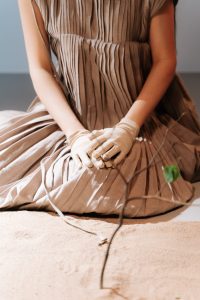31 Tucks
Sheri Deaton
Tucks
A tuck is a stitched fold of the fabric. Tucks are primarily decorative, while released tucks can also add shape and structure to a garment (Deaton, 2021). Tucks add a high-end design quality to a finished product. There are multiple ways to create tucks, with some of the most common being pintucks, dart tucks, blind tucks, and spaced tucks. Regardless of the type of tuck you are creating, you will need patience, marking tools, and opportunities to practice this skill.

For this chapter, we are going to focus on how to create pintucks. Pintucks are very thin folds of fabric that are stitched and ironed to one side. This decorative feature is used on lightweight fabrics, blouses, and dresses, as well as various tailored items like trousers, blazers, and jackets. While pintucks are very narrow and subtle, they make a huge difference to the design of a garment. Finally, although pintucks do not affect fit, they can give the illusion of a slender, taller figure.

TIP: When teaching a new skill or concept to students, spend time activating their minds to help them see where this new learning might fit within their current schema. Below are a few activation questions to consider integrating into your practice as you strive to help students build deeper understandings.
- What do you already know about _________?
- Where have you seen _________ implemented/utilized?
- What skills/techniques do you think would be important to know and possess for the creation of _________?
- Why do you think this is an important skill/concept to understand?
Questions such as this help build students’ connections with the content and build on their current and previous understandings. These Higher Ordered Thinking (HOT) questions or Depth of Knowledge (DOK) questions begin to activate students’ prior knowledge, thus building the connections between former knowledge and current constructs. This scaffolding technique will help new findings to be “tucked” into students’ memories and will better equip them for storing this understanding in their long-term memory (Deaton, 2021).
For more information about HOT questions, check out this Higher Ordered Question article by Dataworks Educational Research.
To learn more about DOK questions and how to integrate them into your educational practice, check out this DOK Wheel Slide for Teachers distributed by The University of Texas.

Perfect Pin Tucks:
- Mark the fold lines 1” apart. It is very important to make these lines consistent.
- Fold and press each of the fold lines. Make sure these are straight.
- Sew each fold line at 3/8” (presser foot distance). Backtack at the beginning and the end of each seam.
- Press the seam allowances flat and in one direction.
- Either use a basting stitch across the top of the stitches or use spray starch to keep the tucks flat. If using starch, spray the starch on the fabric and then iron flat.
TIP: If you want wider tucks, follow the same directions but use 2” tucks, marking the fold lines 2” apart instead of 1” apart.
Hemming it Up
Decorative tucks are an excellent way to add interest and shape to a garment. The applications for tucks are endless, with your creativity being the only limitation. Each variation of a tuck creates a different optical perspective, making this technique a highly valued technique among tailors and fashionistas.
As you prepare to create tucks, ensure that you have adequate lighting, proper sewing and pinning posture, and ample time to focus on the task at hand. Don’t tucker out on this task–keep at it and you will be pleased with the final product!

Resources
| Resource | QR Codes |
| How to Manipulate Fabric with Tucks |  |
| Sewing Beautiful Tucks |  |
| What Are Fabric Tucks And How To Sew Them – Doina Alexei |  |
References
Deaton, S. (2021). Teaching Apparel Production. Presentation.



